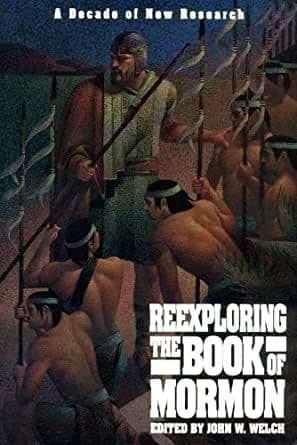Book
85 Chapters

2 Nephi 31:3 “for he speaketh unto men according to their language”
Language is important to the scriptures. In order to communicate effectively, God speaks to mortals “according to their language” (2 Nephi 31:3). As tools for increasing one’s appreciation and understanding of sacred texts, many types of literary studies are helpful.
In an interesting article, “Hebrew Poetry in the Book of Mormon, Part 1,” Angela Crowell briefly describes twenty-three poetic devices found in both the Old Testament and the Book of Mormon.1One of the forms, chiasmus, is by now fairly well known. At the most direct level, the existence of these literary features provides insight to readers of the Book of Mormon enabling them to read it more sensitively—as ancient poetry as well as history. At another level, believers in the scripture will undoubtedly take such materials as further support for the idea that Joseph Smith did not originate the volume.
Several of the forms of parallelism that Crowell discusses also appear in ancient American literature. For example, Munro Edmonson’s introduction to his translation of the Popol Vuh notes that it is written “in poetry, and cannot be accurately understood in prose.”2 The Popol Vuh is entirely composed in parallelistic couplets. Edmonson maintains, moreover, that present-day speakers of Quiche (the original language of the Popol Vuh) “speak to each other, at least most of the time, in the same poetic form.” What one says, one says doubly: for example, “this is my word, . . . is what I say.” This device was used anciently in Mesoamerica. J. E. S. Thompson, the late great Mayanist, said, “There are close parallels in Maya transcriptions of the colonial period, and, I am convinced, in the hieroglyphic texts themselves to the verses of the Psalms, and the poetry of Job.”3
Two other recent papers—one by Richard A. DeLong, the other by Allen J. Christensen—also explore several possible chiastic structures in early Mesoamerican texts, especially in the Annals of the Cakchiquels and the Popol Vuh.
Another form noted by Crowell, called merismus, allowed Hebrew poets to express a broad concept by a pair of narrower adjectives: young and aged = everybody (see Job 29:8); sea and dry land = the universe (see Psalms 95:5); flesh and blood = sacrificed animals (see Psalms 50:13). Crowell notes in Alma 37:37 the use of “night” and “morning” to convey the concept “all the time.”
In Mesoamerica the same device is known as difrasismo or kenning. Among the Aztecs, for example, skirt and blouse signified the sexual aspect of woman, flower and song meant poetry and art, and face and heart signified personality.4 My hand, my foot meant my body; while in the clouds, in the mist conveyed the idea mystery.5 Thus, Edmonson comments on “the extraordinary difficulty” in reading such texts. The “obvious” meaning of an expression frequently must be modified to extract its “synthetic or esoteric meaning,” and a translator is faced with “complex puns, metaphors, and traditional religious symbolisms.” Furthermore, “these [religious] texts are purposely obscure. They are not intended to make sense to outsiders—and they don’t.” They were meant to be “read and pondered rather than skimmed over or recited.”6
Such statements and comparisons recall what Nephi said about Jewish prophecies: “Isaiah spake many things which were hard for many of my people to understand; for they know not concerning the manner of prophesying among the Jews” (2 Nephi 25:1). Their manner of speaking was not readily apparent to his brothers (see 1 Nephi 15:2-3, 7; 22:1) or to Nephi’s children (see 2 Nephi 25:5-6). Accordingly, one might expect to find vestiges of such mannerisms in the Book of Mormon as we have it today.
Although such intercultural studies raise many questions about how such similarities may have occurred, how they may have been transmitted, and what significance they may or may not have, they also add, piece by piece, to our appreciation of the depth of the Book of Mormon and of the ancient cultures with which it had contact.
This Update was based on research by John L. Sorenson, Angela Crowell, and Allen J. Christensen, December 1986. Christensen’s extensive research has been published by F.A.R.M.S., and shorter articles have appeared in the Ensign and in the journal Latin American Indian Literature (see pp. 233 to 235 in this volume).
Work continues steadily on the literary characteristics of the Book of Mormon. A massive three-part listing by Donald W. Parry of different types of parallelisms found in the Book of Mormon was published by F.A.R.M.S. in 1988 (see pp. 167 to 169 and 290 to 292 in this volume). In 1989 other papers were released dealing with the criteria used to evaluate the presence of chiasmus, as well as its presence in Alma 36.
1. Angela Crowell, “Hebrew Poetry in the Book of Mormon, Part 1,” Zarahemla Record, Nos. 32-33 (1986): 2-9.
2. Munro Edmonson, The Book of Counsel: The Popol Vuh of the Quiche Maya of Guatemala,Tulane University, Middle American Research Institute, Publication 35 (1971), xi.
3. J. E. S. Thompson, Maya Hieroglyphic Writing: Introduction (Washington, D.C.: Carnegie Institute of Washington, 1950), 61-62.
4. Miguel Leon Portilla, Pre-Columbian Literatures of Mexico (Norman: University of Oklahoma, 1969), 77.
5. Charlotte McGowan, “The Philosophical Dualism of the Aztecs,” Katunob 10 (December 1977): 45.
6. Munro Edmonson, The Ancient Future of the Itza: The Book of Chilam Balam of Tizimin(Austin: University of Texas, 1982), xiii-xv.
Book
85 Chapters
Items in the BMC Archive are made publicly available for non-commercial, private use. Inclusion within the BMC Archive does not imply endorsement. Items do not represent the official views of The Church of Jesus Christ of Latter-day Saints or of Book of Mormon Central.